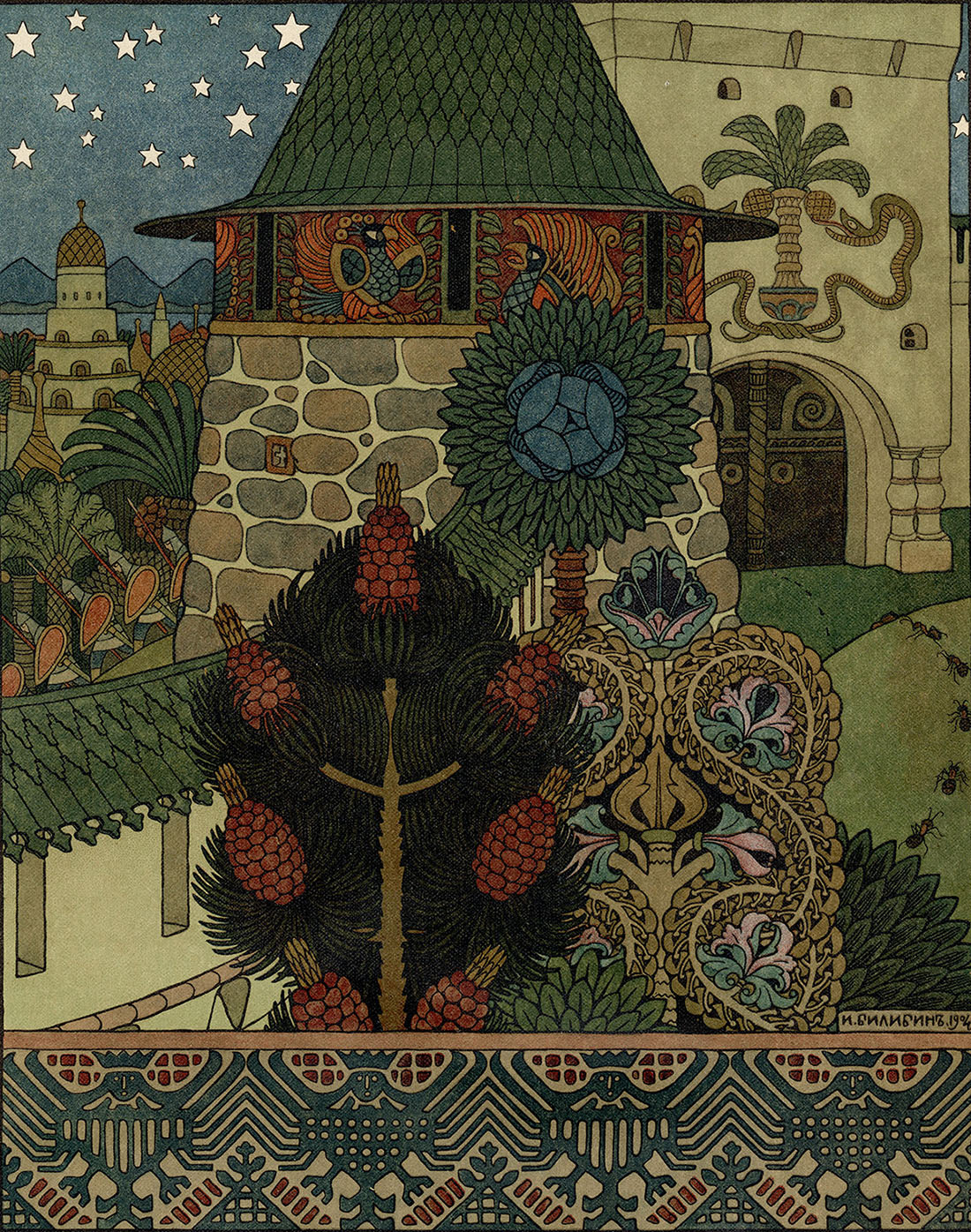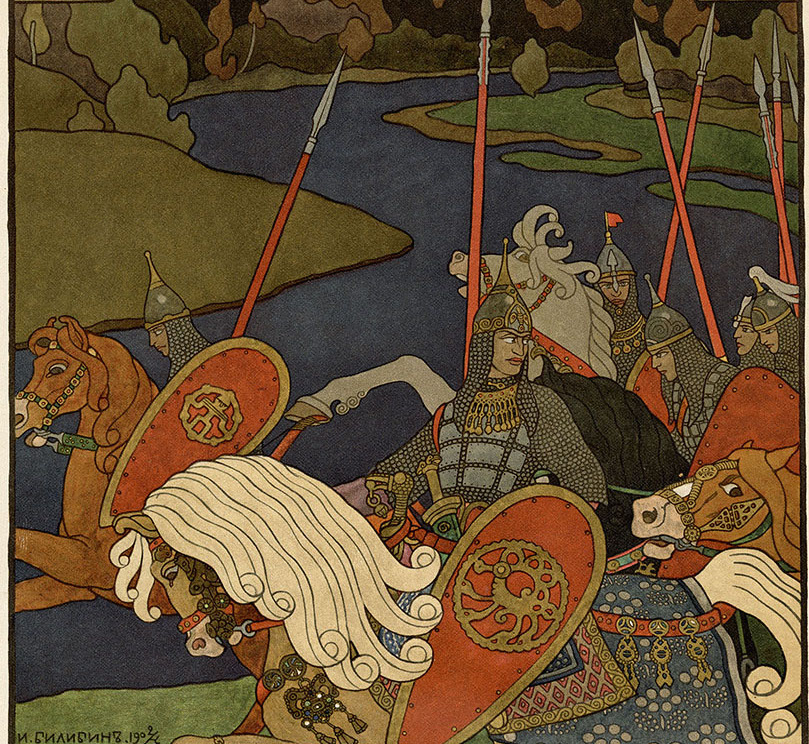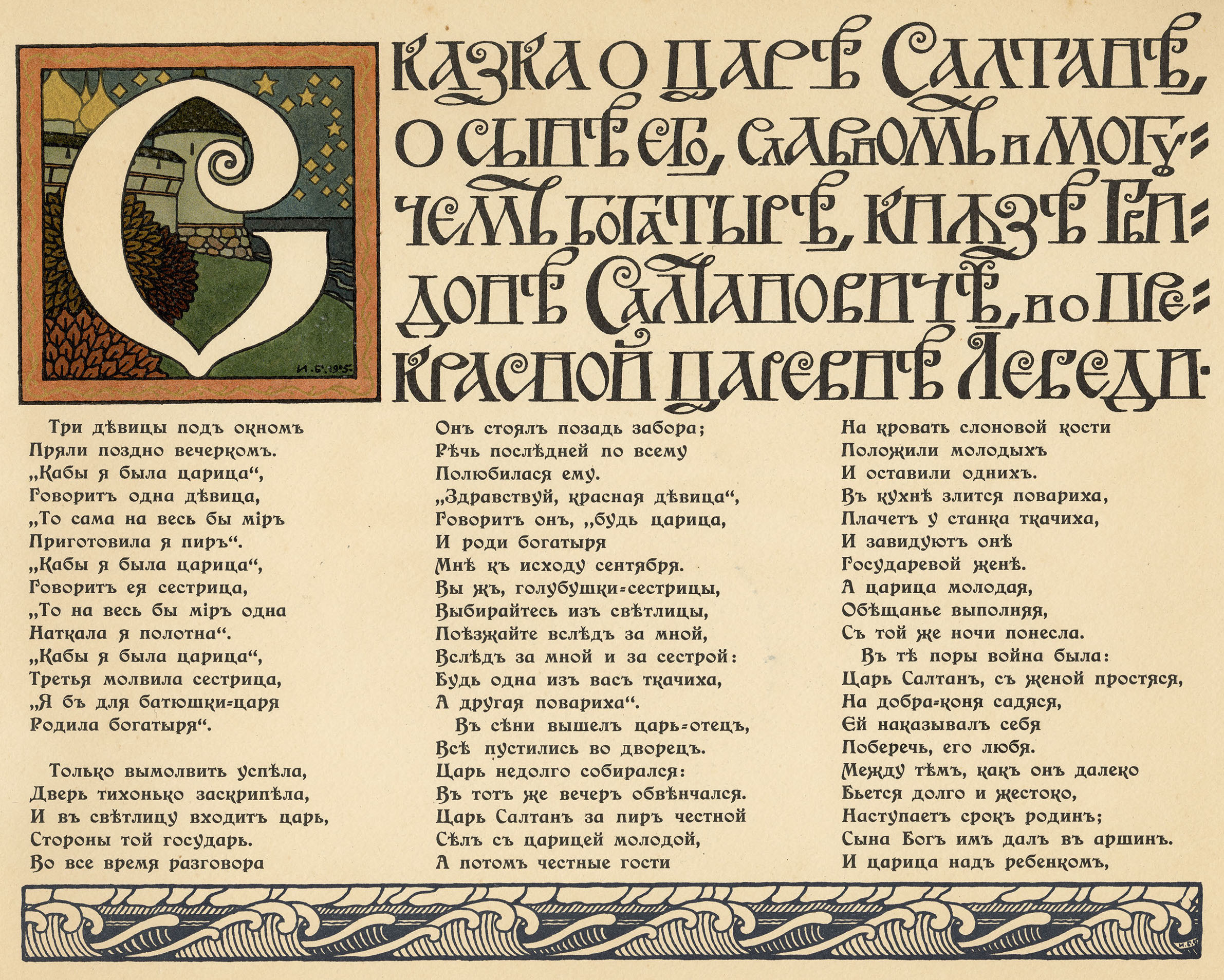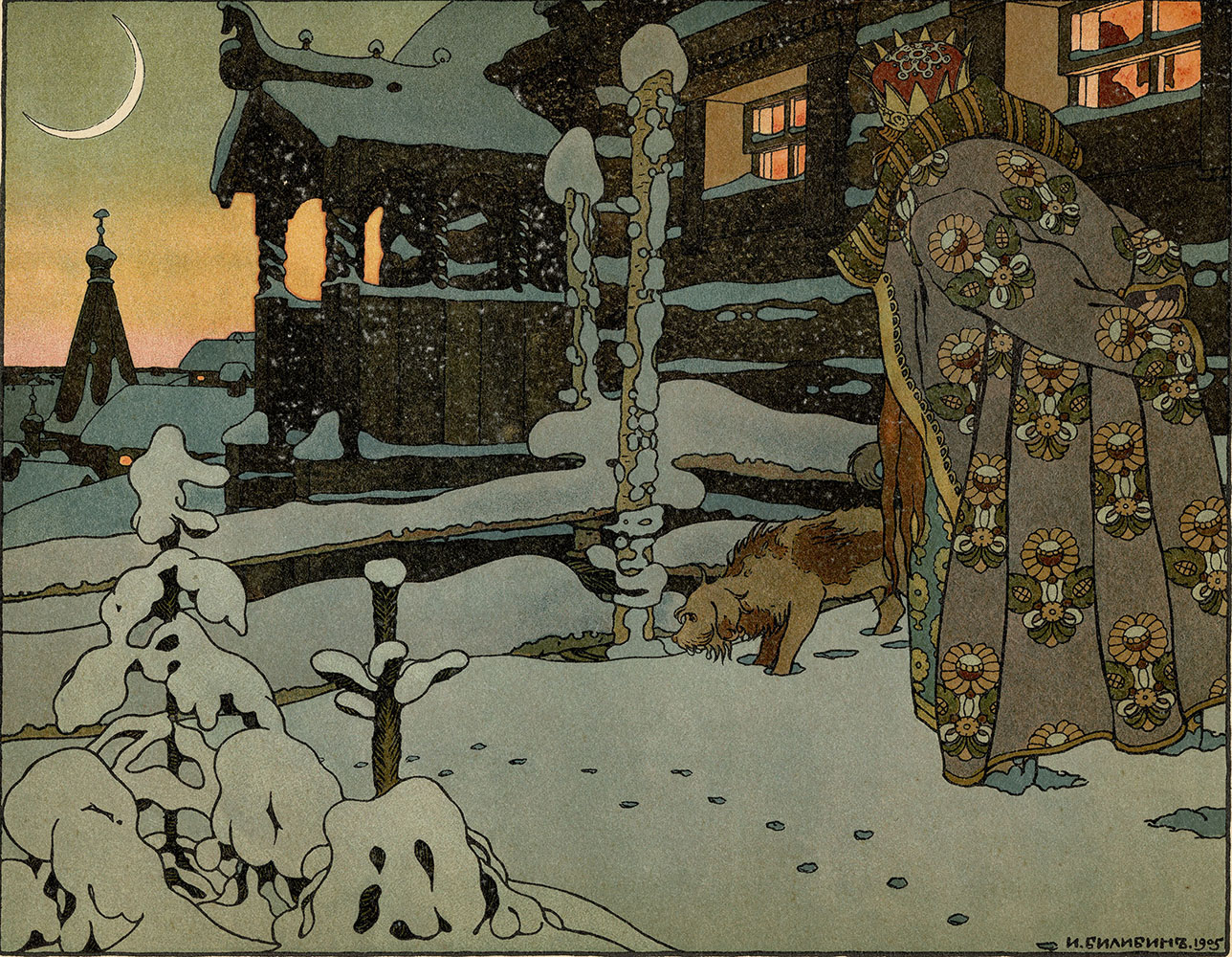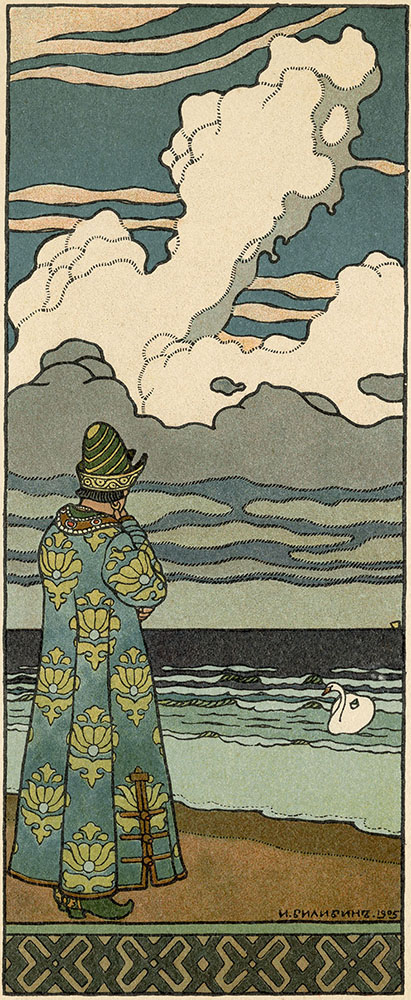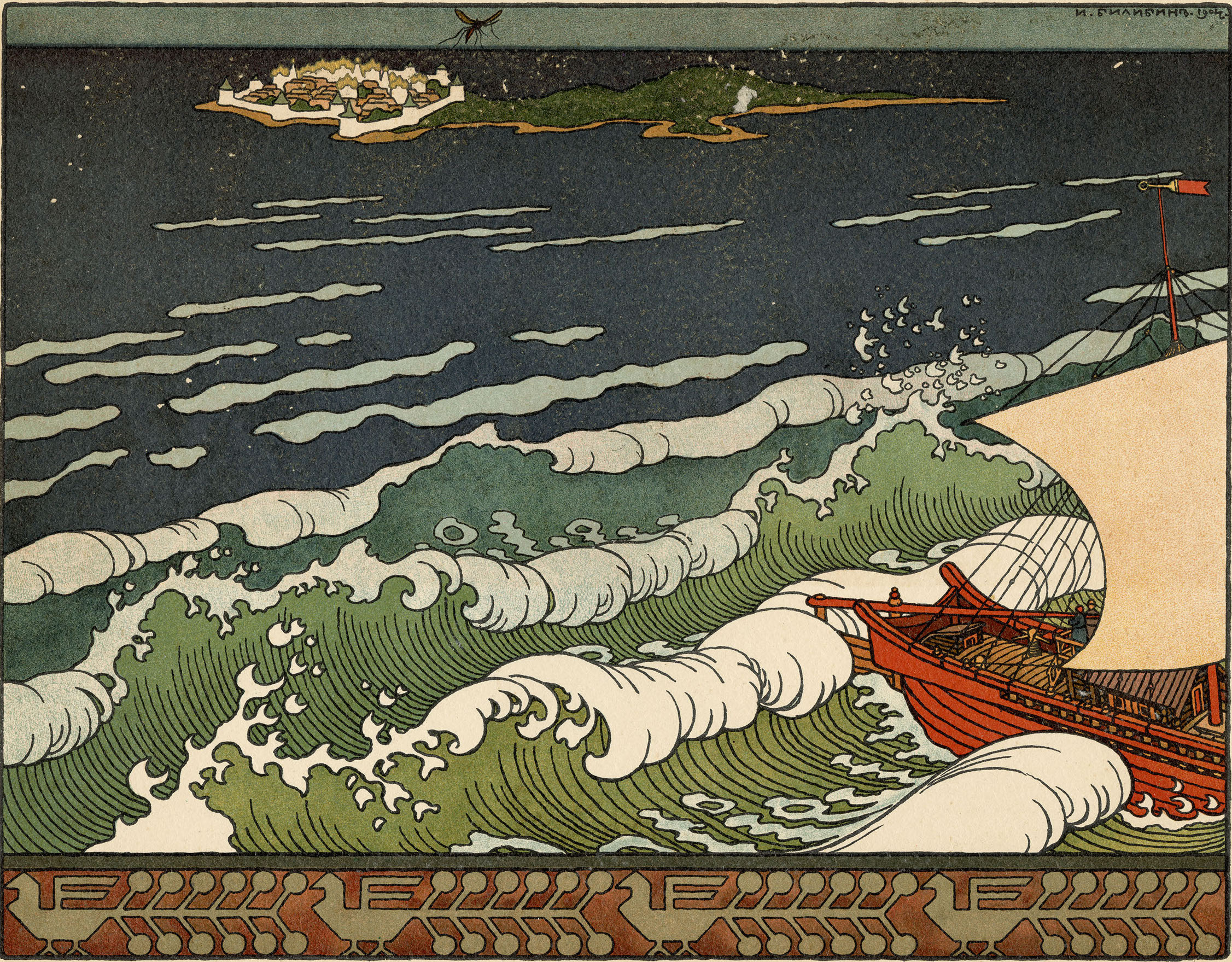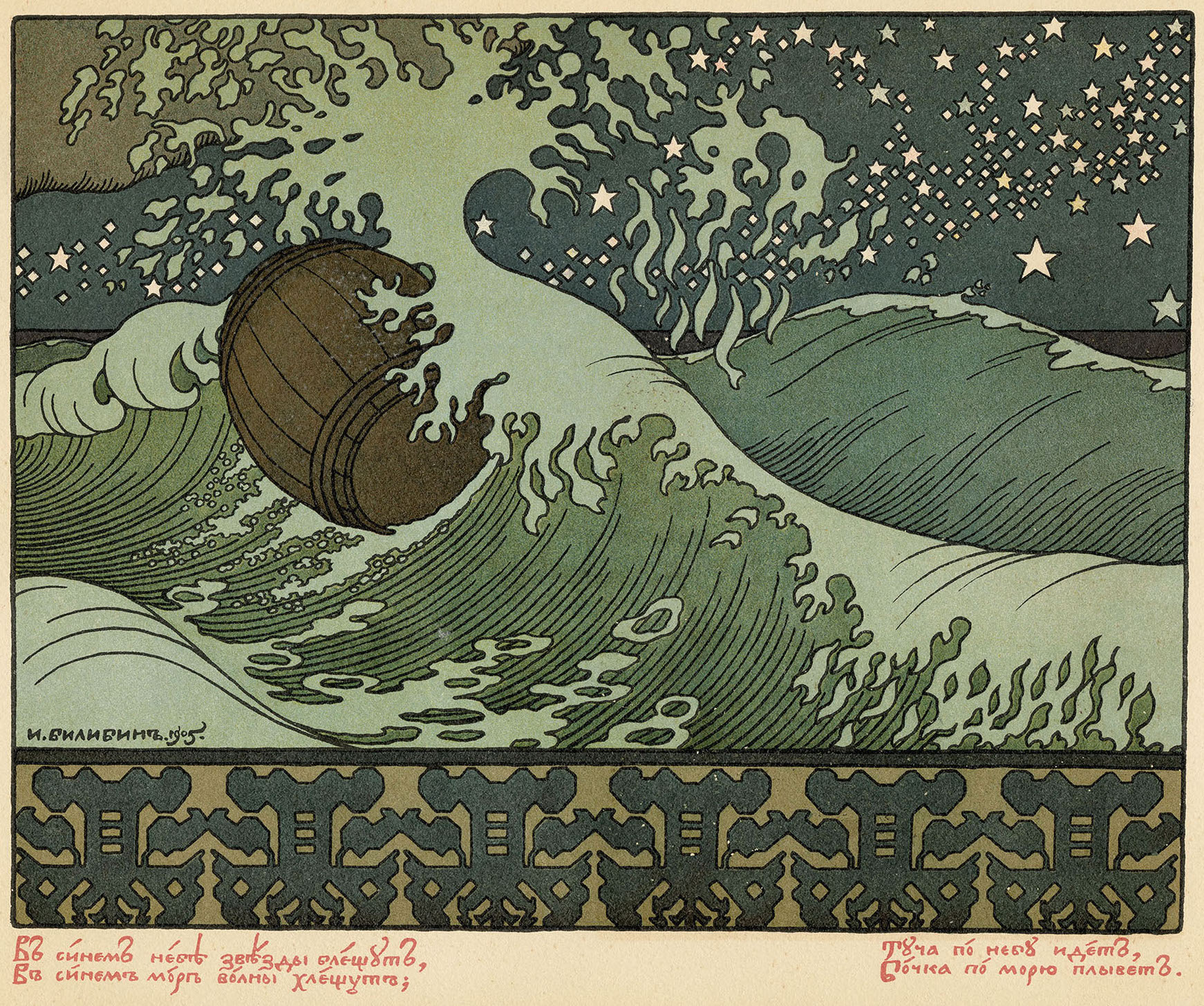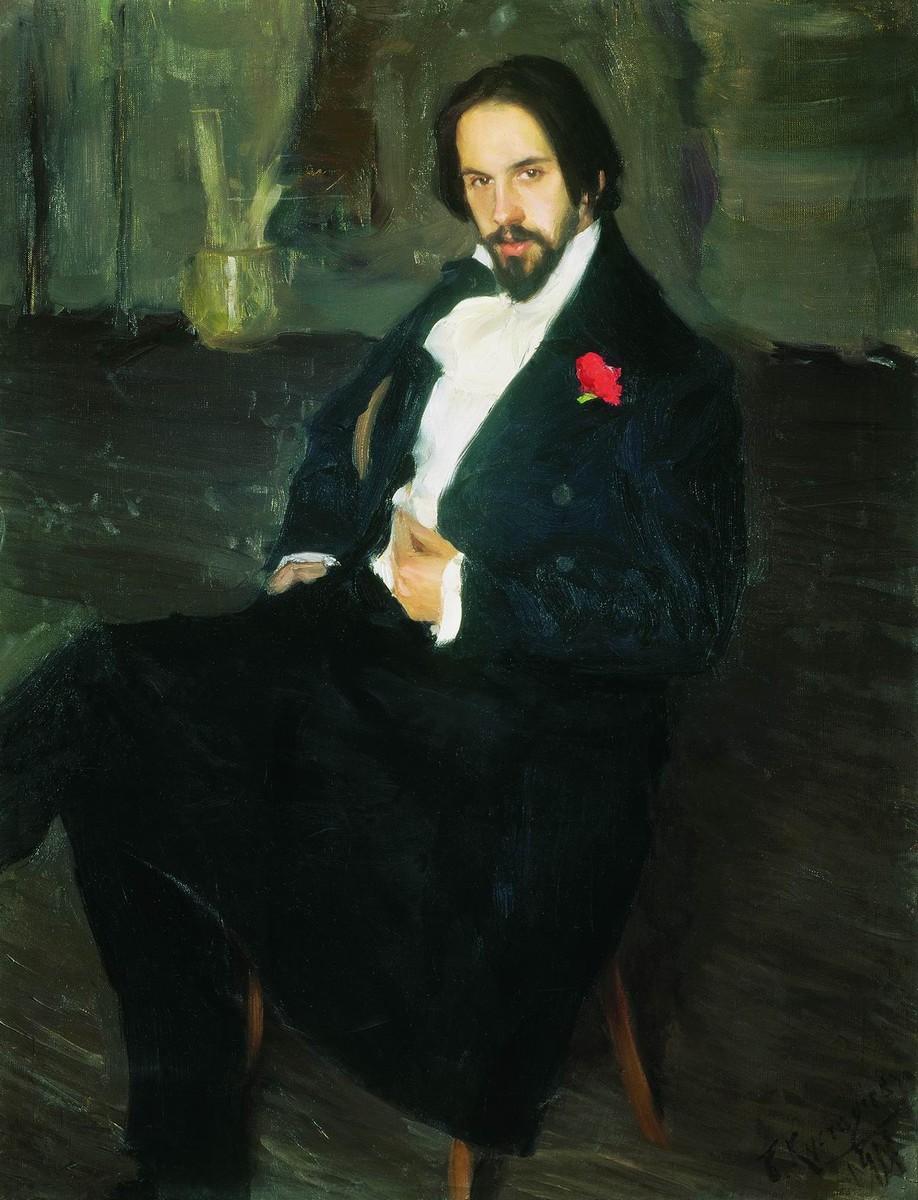“Bilibin . . . changed the very nature of graphic art.” –N. Radlov, 1917 (in Golynets 1981, 191)
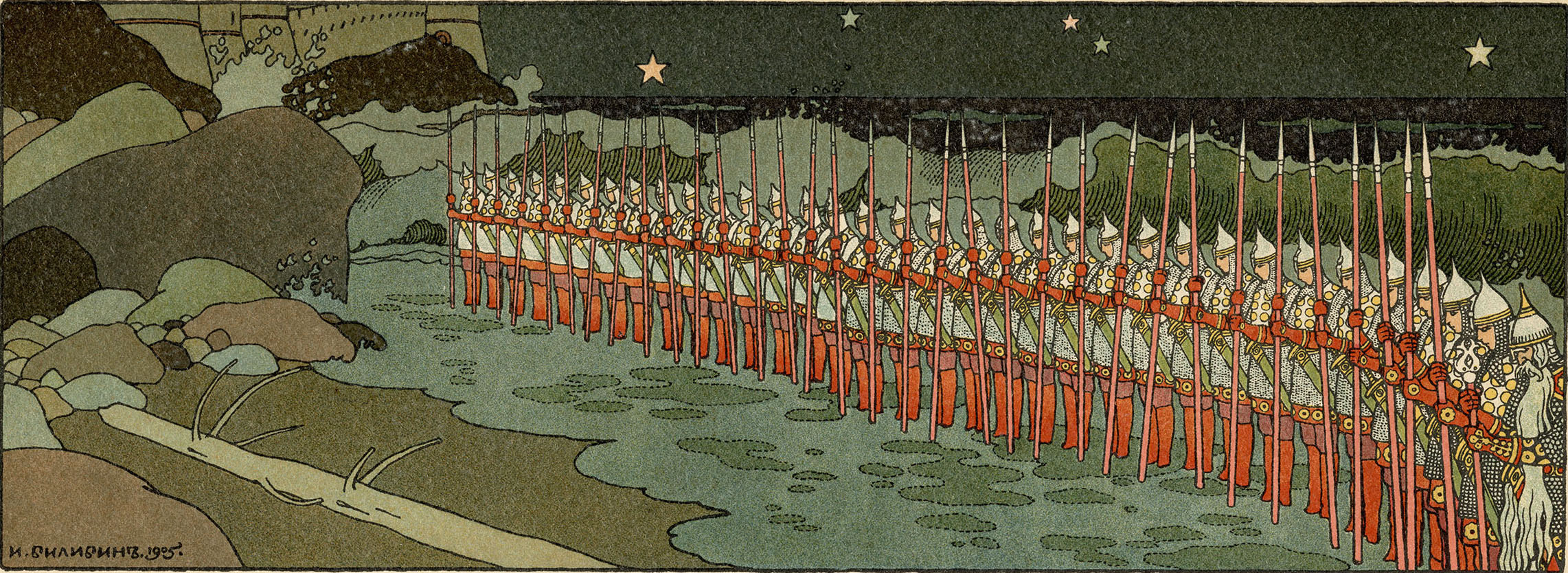
Ivan Bilibin (1876–1942) joined Mir Iskusstva (The World of Art) in 1900, soon after he began contributing to their journal. He later credited this group for introducing him to Western art: “I learned a great deal from Mir Iskusstva. . . . The pages of the journal were like a ‘window on Europe’ for me” (Bilibin 1970, 59).
Like the artists of Western Art Nouveau and its Russian embodiment in Mir Iskusstva, Bilibin was intensely interested in the notion of the “line.” “In graphic art at the beginning of the twentieth century. . . we [cultivated] the line in itself . . . and a strict decorative-linear discipline, . . . as found in Renaissance woodcuts, Japanese art, and ancient Russian art . . . when the master’s relation to each line had to be precise, attentive, and sparing” (Bilibin, in Golynets 1988, 9–10).
Bilibin shared with other artists of his time a fascination with Japanese woodblock prints and the graphic design of Western artists, such as William Morris, Walter Crane, and Aubrey Beardsley (Verizhnikova 2001, 20–24). Bilibin’s work thus reflects the tendencies of Art Nouveau, yet Bilibin forged his own distinct path.
Back to Top of Page
Unlike the Westernizing faction of Mir Iskusstva, discussed in the previous essay, Bilibin’s aesthetic emphasis was on the more ancient culture of Muscovite Russia, dating to the seventeenth century and earlier, which preceded the Westernization of Peter the Great. In this sense Bilibin followed in the footsteps of the Abramtsevo Circle and Vasnetsov's Neo-Russian style. Bilibin was “enraptured by the decorative effect of small-scale patterns, . . . the bright coloring characteristic of seventeenth-century Russian art” (Golynets 1981, 8).
Bilibin pursued his interest in Old Russia very assiduously, conducting ethnographic trips (1902–1904) to Northern Russia, where he took photographs of Old Russian architecture, researched local crafts, and collected folkloric artifacts and “objects of everyday peasant life” (Golynets 1981, 8). He was particularly intrigued by the illustrated broadsides (lubki) that he saw in peasant homes and elsewhere (read more about Bilibin and lubki). After his journeys to the North, he wrote: “Just like America, ancient, artistic Russia [Rus’] has recently been discovered, . . . covered with dust and mildew. But beneath the dust she was so beautiful that the cry of those discovering her makes perfect sense: Return! Return!” (Bilibin 1970, 44).
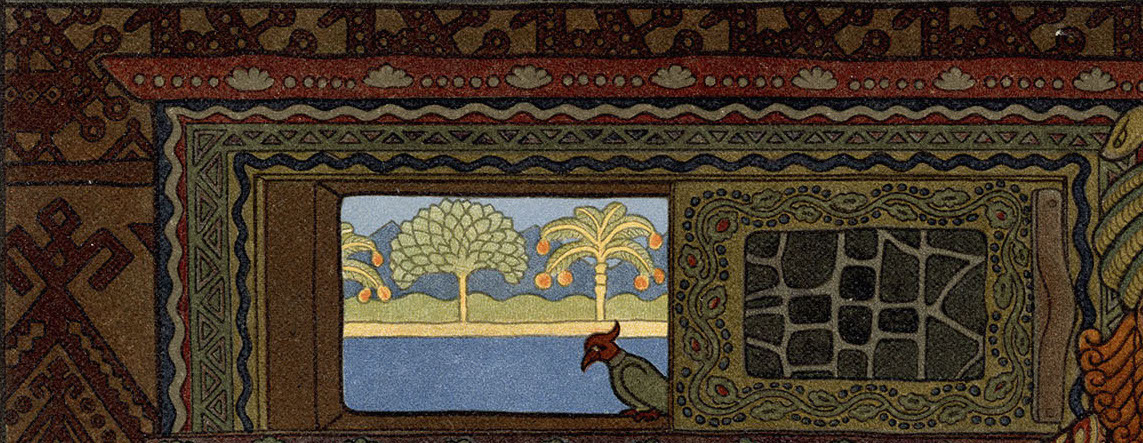
Back to Top of Page
The Poetry of Clothing & Architecture
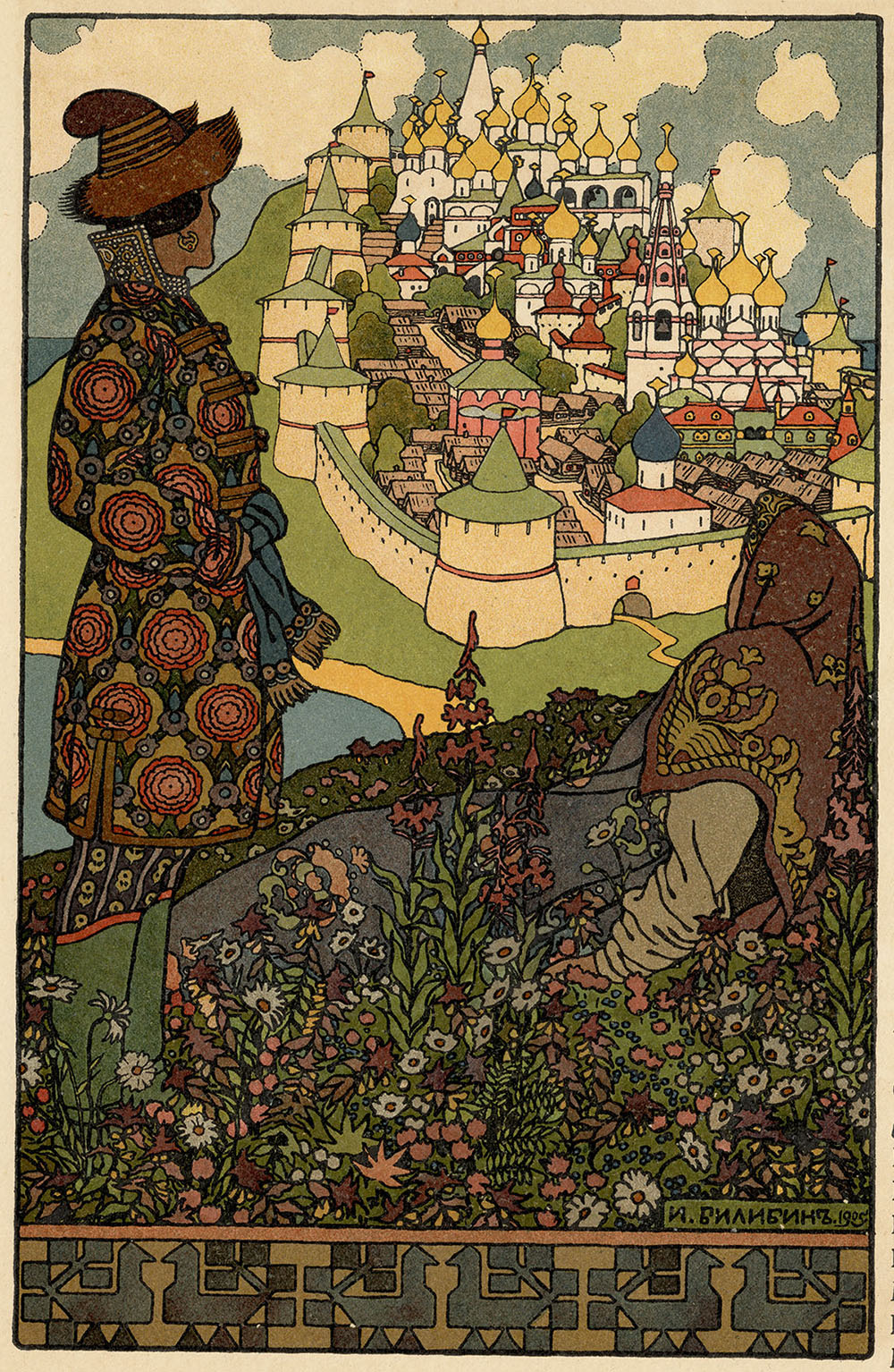
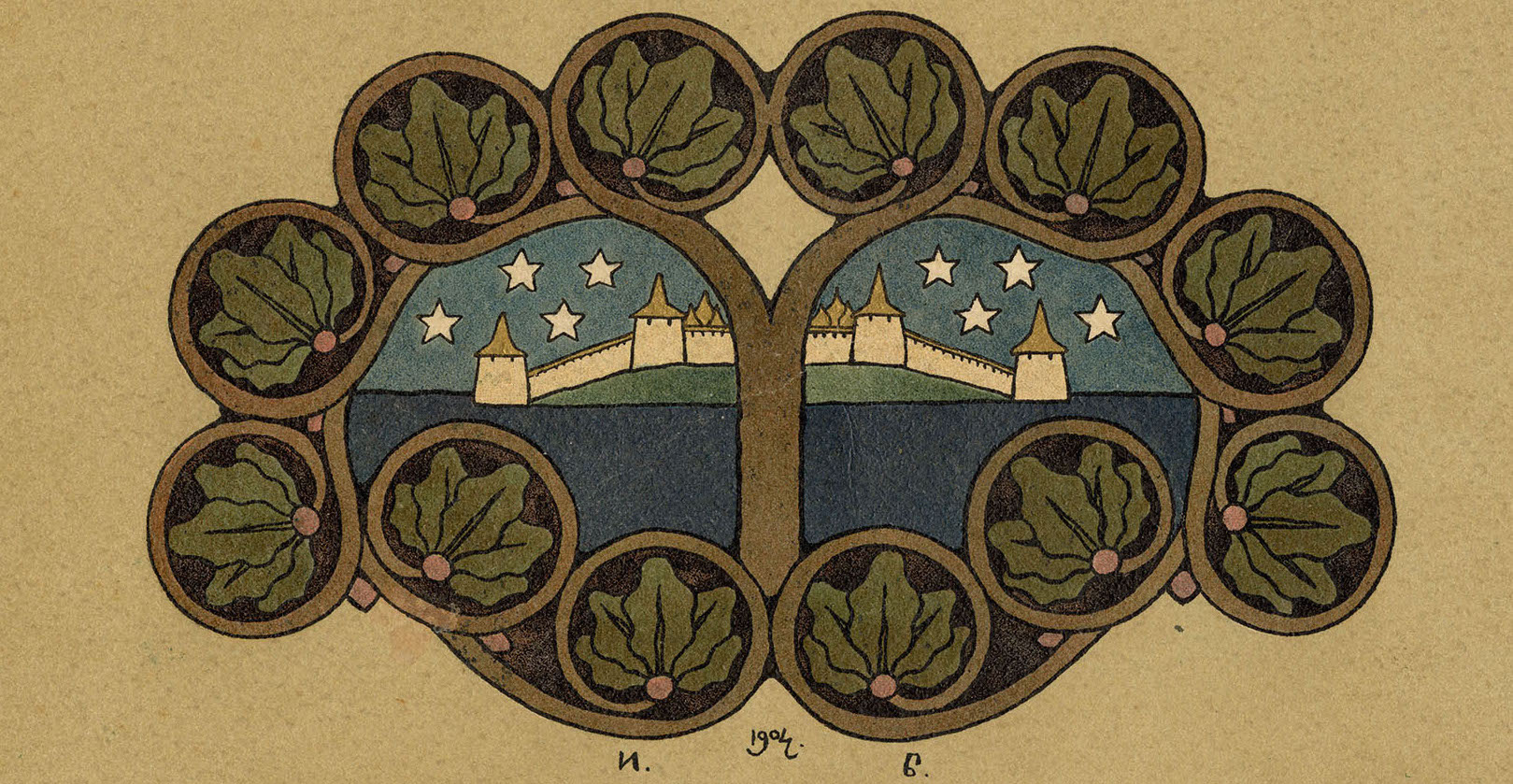
Bilibin was particularly drawn to traditional Russian clothing, as can be seen, for instance, in his illustrations for Tsar Saltan, pages 9 and 11. He later said: “Russian people loved their clothing and filled it with poetry. . . . Russian dress is the dress of peacefulness” (1909, in Bilibin 1970, 47–48).
One could argue that Bilibin’s fascination with the symmetry of Old Russian architecture is reflected in his notion of book design: in his essay on Northern Russia, he wrote that “the main principle in old Russian wooden architecture is that the detail should never drown the whole” and he admired the “balance between the overall outline and detail.” Bilibin also likened architectural details to the elements of a book, comparing the decoration on the church at Kizhi to “a pretty vignette at the end of the text” (1904, in Golynets 1981, 184).
Back to Top of Page
As we saw in the works for children created by Alexandre Benois and Walter Crane, Bilibin also emphasized the book as an integrated work of art, and aimed to merge all visual components into a complete unity. While many of his contemporaries focused on graphic design, Bilibin approached this realm with particular intensity. Golynets argues that, unlike other artists, Bilibin viewed book illustration as a “separate art form” and a “vocation,” not just a sideline (1981, 6). “He helped establish a new approach to the book, where. . . everything. . . is subordinated to a single artistic concept” (Golynets 1981, 15).
Bilibin was particularly attentive to the design of book covers, title pages, stylized typography, border decorations, and vignettes (Jackson 2007, 45; Golynets 1981, 14–15). “Bilibin was singular in devoting his energies to lifting the book as art object to higher realms. . . . His ability to conceive the overall vision of the completed object, rather than place images alongside appropriate section of text as ‘illustrations,’ was unrivalled” (Jackson 2007, 45).
Back to Top of Page
One of Bilibin’s masterpieces is his illustrated version of Pushkin’s Tale of Tsar Saltan (Сказка о Царе Салтане, this edition 1905; Pushkin’s text originally published 1831). Golynets notes that Bilibin’s version of Tsar Saltan is “a consummate expression of Bilibin’s love for the art of seventeenth-century Russia” and that “Bilibin’s illustrations to the great poet’s tales rank among the best” (1981, 10 & 12).
Back to Top of Page
Pushkin's Fairytales
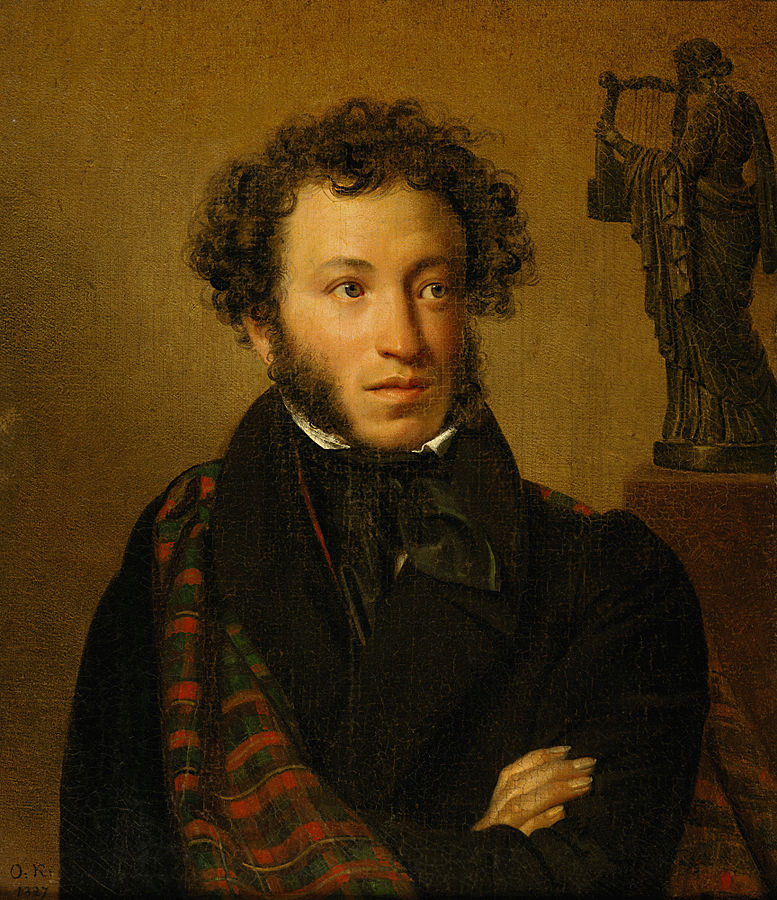
Alexander Pushkin (1799–1837), the most beloved figure in Russian literature, approached the fairytale genre in his own idiosyncratic way with his fairytales in verse, the Skazki (Fairytales or Tales). Many of his contemporaries did not appreciate his efforts, perhaps because his tales did not fit some of the Romantic stereotypes. Unlike many Romantics, Pushkin didn’t indulge in archaic or folk elements for their own sake, instead employing them in the service of a rich imaginative landscape. As John Bayley puts it, “Where the antiquarian left off the dreamer took over” (1971, 56). The motifs and elements of the Skazki have their roots in Russian and Western European folktales, the tales that Pushkin’s nanny told him as a child, as well as in Russian lubki (illustrated broadsides) (For more information, read this essay on the Russian Lubok). However, they are not just adaptations of those sources, but rather are completely original works (Slonimskii 1976, 235–36; Gorodetskii 1966, 437–39).
Pushkin wrote six Skazki, from 1830–34, but arguably the most powerful is the Tale of Tsar Saltan (1831): “Tsar Saltan is a perfect lyrical masterpiece, the most formally beautiful of [the Skazki], and the one that most sustains throughout the length of the tale the atmosphere and taste of magic” (Bayley 1971, 53).
Back to Top of Page
Unlike many traditional fairytales, Pushkin’s Tsar Saltan focuses not on formulaic or magical plot elements, but on vivid external details and the hero’s mercurial emotional state. Underscoring the predominance of psychology over sorcery is the fact that Prince Gvidon’s dilemma (his desire for a reunion with his father) is resolved not magically, but through his father’s own decision to finally ignore his meddlesome advisors. More individualized than stock fairytale characters, Prince Gvidon is characterized through repeated lyrical passages in which he gazes at the sea and interacts with the Swan Princess, his pensive mood framed by concise, rhythmic images of the waves.
The Prince paces again by the sea,
Always gazing at the dark-blue sea;
Look — Above the water flowing
Swims the white swan.
“Greetings, my prince so fair!
Why are you as silent as a storm-cloudy day?
What saddens you so?”
Снова князь у моря ходит,
С синя моря глаз не сводит;
Глядь — поверх текучих вод
Лебедь белая плывет.
«Здравствуй, князь ты мой прекрасный!
Что ж ты тих, как день ненастный?
Опечалился чему?»
Bilibin captures this repeated motif of the melancholy prince in his illustration on page 13. Prince Gvidon’s mood is reflected in the enormous cloud overhead, which bursts with energetic swirls and dominates the landscape as if it were a persona in its own right, dwarfing the tiny swan in the corner of the frame.
Back to Top of Page
Bilibin’s visual treatment of the cloud, in fact, evokes Pushkin’s own approach to landscape elsewhere in the poem, which is granted more tangibility and dynamism than often found in traditional fairytales. The wave, in particular, joins the action and is imbued with as much personality as the human characters:
Wave, my wave!
You are so free and wandering
You splash where you wish,
You sharpen the stones of the sea…
Ты, волна моя, волна!
Ты гульлива и вольна
Плещешь ты, куда захочешь,
Ты морские камни точишь…
Bilibin’s illustrations evoke the centrality of the wave image in Pushkin’s poem by twice making it the centerpiece of the page (pages 8 & 10).
Back to Top of Page
Bilibin’s illustration on page 8 endows Pushkin’s wave with both dynamism and delicacy: its ebullient energy recalls woodcuts by the Japanese artist Katsushika Hokusai (1760–1849), especially the famous The Great Wave off Kanagawa (c. 1830). Meanwhile its ornamental border evokes Russian folk art (Golynets 1981, 10; Rosenfeld 2014, 180). Bilibin’s book design thus reflects his eclectic mélange of sources.
This illustration also highlights one of the famous moments of the poem: young Prince Gvidon and his mother traveling the sea while trapped in a barrel. This passage exemplifies Pushkin’s terse syntax and rhythmic musicality, which frames the characters’ stark dilemma against the laconic simplicity of the surrounding landscape:
A storm-cloud travels across the sky
The barrel swims across the sea
Бочка по морю плывёт
Туча по небе идёт
Bóchka pó moryú plyvyót
Túcha pó nebé idyót
As Samuil Marshak aptly noted, “The absence of other details makes the sky and ocean seem enormous, each occupying an entire line” (1968–72, 7:8). The passage also embodies Pushkin’s characteristic concision: “The phrases … contain no single superfluous word” (Slonimsky 1976, 236).
Back to Top of Page
Bilibin’s students remembered him as a powerful mentor and a figure of eccentric charm:
“Ivan Yakovlevich was a charming person, handsome with his black beard, and always elegantly dressed. He was inclined to stammer, and this made his witty rejoinders during classes sound even more funny….Bilibin’s firm, calligraphically sharp line and his craftsmanship caused many to imitate him” —N. Kuzmin (in Golynets 1981, 193).
“Bilibin taught us to understand and love Russian folk art. . . . He called himself Ivan the Iron Hand. He only worked with a brush and never with a pen. . . . He told us that the Byzantine artists fasted and prayed before setting about their work and that we should do the same” (Renee O’Connell-Mikhailovskaya, Bilibin’s first wife and former student, in Golynets 1981, 192).
Back to Top of Page
